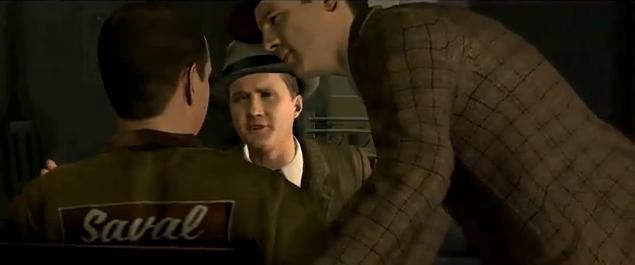'L.A. Noire': Interactive's Big Night
The other night I attended the premiere of a video game. It was an odd little duck — the premiere, that is. The video game is L.A. Noire, an interactive thriller from Rockstar Games (coming out in May), and it was not odd at all. But the premiere was a bit of a puzzle.
In many aspects, it was more traditional roll-out than premiere — a demonstration of the product, followed by prepared remarks from the company and then a Q&A; for the fans. But this was not Comic Con or E3 Expo, where we’d expect a whole weekend’s worth of such events; this was at the Tribeca Film Festival. And to answer the question of why L.A. Noire was occupying a slot at the Festival was Geoff Gilmore, the host for the event and also the festival’s chief creative officer (and former longtime director of the Sundance Film Festival). Gilmore has no small amount of cinema street cred in the bank, and he was visibly excited to present this premiere of what he described as “a whole new sphere of storytelling: narrative gaming.”
The movie business and the video game business (or the “interactive” business, as it’s known) have been flirting for some time. Blockbusters get licensed to interactive producers for video games (even E.T.!), and sometimes games get developed into movies (i.e., the Resident Evil series). Each of course is vying for a sometimes-overlapping audience, but as technologies advance and delivery platforms begin to resemble each other, this flirtation is becoming a bit more serious, though still awkward. And the tone of the event, from the perspective of Gilmore and the TFF, was an invite to the interactive industry to go back to cinema’s room later that night. Interactive, from the tone of Rockstar, is playing hard to get. The company’s reps, Rob Nelson and Simon Ramsey, while seeming pleased to be there, were clearly more focused on promoting the game than celebrating any potential union between the sectors. When asked to identify the game’s ideal audience, Ramsey answered that Rockstar was not just looking to Rockstar fans (who comprised the majority of the audience), but also to fans of film noir. And what better venue to reach these fans than a high-profile film festival? And if the initial outreach to cineastes is in the guise of a serious discussion of the arts, then so much the better.
The game itself is a bright shiny thing. Immaculately art-directed, it takes place in the Los Angeles of 1947, and the protagonist (“you”) is a WWII hero recently promoted to detective, trying to solve a series of grisly (and graphic) murders. The animation of the characters’ faces was mapped using a new process that approximates photographic-level graphics, and it’s impressive, as is the richness of the period LA scenery. It was written and directed by Brendan McNamara, and features a cast of 400 and a “script” of 2,300 pages. As progress in the game is ultimately determined by engaging in a series of interrogations of potential suspects in which you, the player, must determine the truthfulness of statement — literally by choosing between Truth/Doubt/Lie after each interogatee response — both the script and the facial animation are much more important than they would be in, say, a first-person shooter.

As pretty as the game is, the product demo of the game was an interesting experience, in the full sense of that word. It was novel, if not newsworthy, to get a peek at the next big Rockstar game (considering their track record), and at the same time it was squirmy. The demo was a live projection of one of the Rockstar team playing an early chapter, and watching a stranger play a videogame is as stultifying as it sounds. The cut scenes which lay out the arc of the story are fun, but when the game proceeds into actual play there are small gaps and pauses that the gamer takes in stride when playing but are less than riveting for those looking over his shoulder. All of the dull parts of game play — driving the car from scene to scene, climbing the stairs — were live and in real time. And to watch and not be distracted by mashing your thumbs, your attention is freed to wander and notice the little things, good and bad — the richness of the sound design, and the incongruity between near-human facial gestures and weirdly mapped fabric (which is notoriously hard to depict via CGI). A live demonstration was not as evocative as perhaps the organizers had hoped.
That point where video games are so immersive as to become watchable by third parties is not that far away, though, and L.A. Noire is a clear effort to approach that point. It’s very pretty and very well realized, but at the same time, the fact that the mechanics are based on interrogations, on an immense but still finite logic tree, can be reminiscent of reading a souped-up “Choose Your Own Adventure” book. Above all this, the decision of the TFF to “premiere” L.A. Noire, is a component of the engaging gospel of Geoff Gilmore: finding the places where cinema overlaps similar media, and to even find a Unified Field Theory of Narrative. And while L.A. Noire may not be the apotheosis of that, the event was a window on the ways the two industries will step on each other’s toes while they consider the prospect of finally getting it on.
